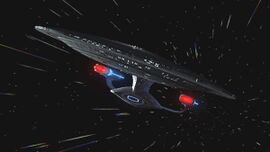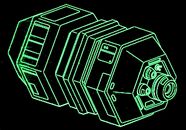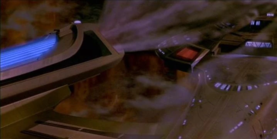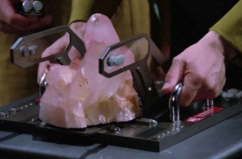Difference between revisions of "Engineering Glossary"
CrimsonTacit (talk | contribs) |
Teylasramar (talk | contribs) |
||
| (One intermediate revision by one other user not shown) | |||
| Line 1: | Line 1: | ||
{{Icons|bfc|tech}} | |||
{{workinprogress}} | |||
This Engineering Glossary is a guide to common terms one may encounter while serving aboard a starship. The heading of each term will take you out of this system to Memory Alpha. | This Engineering Glossary is a guide to common terms one may encounter while serving aboard a starship. The heading of each term will take you out of this system to Memory Alpha. | ||
| Line 21: | Line 23: | ||
=== [[ma:Dilithium|Dilithium]] === | === [[ma:Dilithium|Dilithium]] === | ||
[[File:Stdilithiumcrystals2.png|alt=A dilithium crystal installed in a dilithium articulation frame, ready to be inserted into a matter/antimatter reaction chamber.|thumb|242x242px|A dilithium crystal in an articulation frame.]] | |||
Dilithium is a crystaline compound that is the only known way of moderating a matter/anti-matter reaction. Without dilitihium, traditional warp cores cannot function.<ref name=":0" /> This substance can be refined or synthesized from its component parts, but it cannot be replicated. Dilithium decrystalizes with use but is not consumed by the reaction process. Decrystalized dilithium can be recrystalized with gamma radiation bombardment<ref>''[[ma:Star_Trek_IV:_The_Voyage_Home|Star Trek IV: The Voyage Home]]''</ref> or a theta matrix compositer<ref>[[ma:Family_(episode)|''Star Trek: The Next Generation'', Season 4, Episode 2: "Family"]]</ref>, but there will always be material lost during this process, as it is only about 50% efficient with current methods. This means that spacefaring races must rely on having access to substantial, active sources of dilithium or they risk losing the ability to power their ships. | Dilithium is a crystaline compound that is the only known way of moderating a matter/anti-matter reaction. Without dilitihium, traditional warp cores cannot function.<ref name=":0" /> This substance can be refined or synthesized from its component parts, but it cannot be replicated. Dilithium decrystalizes with use but is not consumed by the reaction process. Decrystalized dilithium can be recrystalized with gamma radiation bombardment<ref>''[[ma:Star_Trek_IV:_The_Voyage_Home|Star Trek IV: The Voyage Home]]''</ref> or a theta matrix compositer<ref>[[ma:Family_(episode)|''Star Trek: The Next Generation'', Season 4, Episode 2: "Family"]]</ref>, but there will always be material lost during this process, as it is only about 50% efficient with current methods. This means that spacefaring races must rely on having access to substantial, active sources of dilithium or they risk losing the ability to power their ships. | ||
=== Matter/Antimatter Reaction Assembly (M/ARA) === | === [[ma:Warp_core|Matter/Antimatter Reaction Assembly (M/ARA)]] === | ||
[[File:IntrepidWarpCore.jpg|thumb|The reaction chamber of an [[Intrepid Class|''Intrepid''-class starship]]'s matter/antimatter reactor, known as a dilithium swirl chamber.]] | |||
Known more commonly as the warp core, the Matter/Antimatter Reaction Assembly uses the controlled intermixing of deuterium and anti-deuterium to create energy in the form of plasma to power a starship's warp engines and other systems. At each end of the warp core, there is a reactant injector connected to either the ships deuterium tanks (the matter reactant injector or MRI) or anti-deuterium tanks (the antimatter reactant injector or ARI). These injectors control the rate of flow into the reaction assembly, and thus the amount of power being generated. The magnetic constrictor segments are the next major component of the M/ARA, connecting the reactant injectors to the reaction chamber. These segments use intense magnetic fields to channel the reactants at the right angle and pressure. The reaction chamber uses dilithium to mediate the matter/anti-matter reaction, and this is where the two substances annihilate one another to create plasma, which is channeled to the warp coils through the power transfer conduits.<ref name=":0">Sternbach, R., & Okuda, M. (1993). Section 5.2: Matter/Antimatter Reaction Assembly. In ''Star Trek: The next generation technical manual'' (pp. 57–62). Pocket.</ref> It normally takes at least thirty-minutes to start a warp core from cold<ref>[[ma:The_Naked_Time_(episode)|''Star Trek: The Original Series'', Season 1, Episode 6: "The Naked Time"]]</ref>, but more rapid cold starts are possible with the precise alignment of the injectors.<ref>[[ma:Human_Error_(episode)|''Star Trek: Voyager'', Season 7, Episode 18: "Human Error"]]</ref> In catastrophic emergency situations where damage has been sustained to the M/ARA and a warp core breach is imminent, the warp core of nearly every starship can be jettisoned through a hatch, most often on the keel of the ship.<ref>Sternbach, R., & Okuda, M. (1993). Section 5.10: Catastrophic Emergency Procedures. In ''Star Trek: The next generation technical manual'' (pp. 73–74). Pocket.</ref> | Known more commonly as the warp core, the Matter/Antimatter Reaction Assembly uses the controlled intermixing of deuterium and anti-deuterium to create energy in the form of plasma to power a starship's warp engines and other systems. At each end of the warp core, there is a reactant injector connected to either the ships deuterium tanks (the matter reactant injector or MRI) or anti-deuterium tanks (the antimatter reactant injector or ARI). These injectors control the rate of flow into the reaction assembly, and thus the amount of power being generated. The magnetic constrictor segments are the next major component of the M/ARA, connecting the reactant injectors to the reaction chamber. These segments use intense magnetic fields to channel the reactants at the right angle and pressure. The reaction chamber uses dilithium to mediate the matter/anti-matter reaction, and this is where the two substances annihilate one another to create plasma, which is channeled to the warp coils through the power transfer conduits.<ref name=":0">Sternbach, R., & Okuda, M. (1993). Section 5.2: Matter/Antimatter Reaction Assembly. In ''Star Trek: The next generation technical manual'' (pp. 57–62). Pocket.</ref> It normally takes at least thirty-minutes to start a warp core from cold<ref>[[ma:The_Naked_Time_(episode)|''Star Trek: The Original Series'', Season 1, Episode 6: "The Naked Time"]]</ref>, but more rapid cold starts are possible with the precise alignment of the injectors.<ref>[[ma:Human_Error_(episode)|''Star Trek: Voyager'', Season 7, Episode 18: "Human Error"]]</ref> In catastrophic emergency situations where damage has been sustained to the M/ARA and a warp core breach is imminent, the warp core of nearly every starship can be jettisoned through a hatch, most often on the keel of the ship.<ref>Sternbach, R., & Okuda, M. (1993). Section 5.10: Catastrophic Emergency Procedures. In ''Star Trek: The next generation technical manual'' (pp. 73–74). Pocket.</ref> | ||
=== Warp Nacelle === | === [[ma:Nacelle|Warp Nacelle]] === | ||
A warp nacelle is an outboard cylindrical structure (i.e. a nacelle) that contains a vessel's warp coils.<ref>Sternbach, R., & Okuda, M. (1993). Section 5.3: Warp Field Nacelles. In ''Star Trek: The next generation technical manual'' (pp. 63–64). Pocket.</ref> Federation starships tend to have their nacelles in pairs arranged symmetrically. In fact, it is so common for nacelles to come in pairs that the phrase "third nacelle" has entered the vernacular as a 24th and 25th-century equivalent to the phrase "third wheel"<ref>[[ma:Inside_Man_(episode)|''Star Trek: Voyager'', Season 7, Episode 6: "Inside Man"]]</ref>. Starfleet warp nacelles almost always have bussard collectors. A starship's nacelles are a good indication of which era it was designed in, as the nacelles for multiple classes in a single period tend to share characteristics (or are actually identical), reflecting the trends in warp coil design at the time. | A warp nacelle is an outboard cylindrical structure (i.e. a nacelle) that contains a vessel's warp coils.<ref>Sternbach, R., & Okuda, M. (1993). Section 5.3: Warp Field Nacelles. In ''Star Trek: The next generation technical manual'' (pp. 63–64). Pocket.</ref> Federation starships tend to have their nacelles in pairs arranged symmetrically. In fact, it is so common for nacelles to come in pairs that the phrase "third nacelle" has entered the vernacular as a 24th and 25th-century equivalent to the phrase "third wheel"<ref>[[ma:Inside_Man_(episode)|''Star Trek: Voyager'', Season 7, Episode 6: "Inside Man"]]</ref>. Starfleet warp nacelles almost always have bussard collectors. A starship's nacelles are a good indication of which era it was designed in, as the nacelles for multiple classes in a single period tend to share characteristics (or are actually identical), reflecting the trends in warp coil design at the time. | ||
Latest revision as of 21:14, 11 March 2024
This Engineering Glossary is a guide to common terms one may encounter while serving aboard a starship. The heading of each term will take you out of this system to Memory Alpha.
Warp Drive
Warp Drive is a form of non-Newtonian propulsion that moves starships faster than the speed of light by manipulating subspace to bend space and reduce the apparent mass of the vessel in order to bypass the laws of Relativity.[1] Without warp drive, journeys between star systems would be impossible without sleeper or generation ships. Federation and Klingon warp drives operate with a matter/antimatter reactor powering warp coils in outboard nacelles, while Romulan warp drives are powered by artificial quantum singularity reactors.[2]
Earlier versions of warp drive could not be operated close to large gravitational masses like planets[3], but this limitation has been removed by the start of the 25th century.[4] Warp drive can be impeded by many things, notably disruptions to subspace. Warp drive systems developed through the mid-24th century also caused direct damage to subspace and for a time Starfleet Command imposed a Warp 5 speed limit except in emergencies.[5] Refinements to Starfleet warp drive designs mitigated this effect by the 2380s, but it led to the accelerated retirement or re-engining of multiple old-style starship classes, including the Miranda and Excelsior.
Many systems have been proposed to travel at even faster speeds than warp drive can (slipstream and transwarp, e.g.), and several alien races such as the Voth and Borg have managed to perfect them, but faster-than-warp technologies remain purely in the purview of experimental prototypes in Starfleet; it is anticipated that warp will remain the dominant mode of interstellar travel in the Alpha Quadrant for at least the first half of the 25th century.
Antimatter
Antimatter is a form of matter with mass but with the opposite charge and spin as standard matter. Matter and antimatter will annihilate each other when they come in contact. It is used in both antimatter reactors and antimatter weapons. Aboard Starfleet vessels, anti-deuterium is used for both of these purposes. It is stored in modules near to the antimatter reactant injectors. Because antimatter cannot come in contact with matter without exploding, it is stored within high-power magnetic forcefields that suspend it in a vacuum. In an emergency, antimatter pods can be ejected from a starship. Refined antimatter is created at facilities around the Federation, and this process is extremely energy intensive.[6] Some starships have onboard antimatter generators, but they are highly inefficient and provide antimatter at a ratio of 1 unit of antideuterium for every 10 units of deuterium provided.[7]
Bussard Collector
Bussard Collectors, also known as Bussard Ramscoops, use magnetic fields to attract interstellar hydrogen atoms and other free-floating gases for use as fuel aboard a starship. Most effective at warp speeds, this system is used to continually replace small amounts of fuel and to provide stop-gap fuel in the event of a shortage.[8] This system can also be used to collect and expel other gasses, for scientific or tactical purposes.[9][10][11] On Starfleet ships, Bussard collectors are always on the forward ends of the warp nacelles. It is a common misconception that they are some sort of intake manifold for the warp engines themselves, but they are not directly connected to the warp coils or any other propulsive systems.
Deuterium
Deuterium is an isotope of hydrogen containing both a proton and a neutron. It is used to fuel starships' matter/antimatter reactors and fusion reactors. Deuterium is stored as slush in large tanks on every starship. A Galaxy-class starship has tanks large enough to support three years of warp travel without refueling.[12] Deuterium is preferred over protium (hydrogen without a neutron) because it contains twice the energetic potential.
Dilithium
Dilithium is a crystaline compound that is the only known way of moderating a matter/anti-matter reaction. Without dilitihium, traditional warp cores cannot function.[13] This substance can be refined or synthesized from its component parts, but it cannot be replicated. Dilithium decrystalizes with use but is not consumed by the reaction process. Decrystalized dilithium can be recrystalized with gamma radiation bombardment[14] or a theta matrix compositer[15], but there will always be material lost during this process, as it is only about 50% efficient with current methods. This means that spacefaring races must rely on having access to substantial, active sources of dilithium or they risk losing the ability to power their ships.
Matter/Antimatter Reaction Assembly (M/ARA)
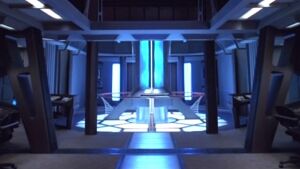
Known more commonly as the warp core, the Matter/Antimatter Reaction Assembly uses the controlled intermixing of deuterium and anti-deuterium to create energy in the form of plasma to power a starship's warp engines and other systems. At each end of the warp core, there is a reactant injector connected to either the ships deuterium tanks (the matter reactant injector or MRI) or anti-deuterium tanks (the antimatter reactant injector or ARI). These injectors control the rate of flow into the reaction assembly, and thus the amount of power being generated. The magnetic constrictor segments are the next major component of the M/ARA, connecting the reactant injectors to the reaction chamber. These segments use intense magnetic fields to channel the reactants at the right angle and pressure. The reaction chamber uses dilithium to mediate the matter/anti-matter reaction, and this is where the two substances annihilate one another to create plasma, which is channeled to the warp coils through the power transfer conduits.[13] It normally takes at least thirty-minutes to start a warp core from cold[16], but more rapid cold starts are possible with the precise alignment of the injectors.[17] In catastrophic emergency situations where damage has been sustained to the M/ARA and a warp core breach is imminent, the warp core of nearly every starship can be jettisoned through a hatch, most often on the keel of the ship.[18]
Warp Nacelle
A warp nacelle is an outboard cylindrical structure (i.e. a nacelle) that contains a vessel's warp coils.[19] Federation starships tend to have their nacelles in pairs arranged symmetrically. In fact, it is so common for nacelles to come in pairs that the phrase "third nacelle" has entered the vernacular as a 24th and 25th-century equivalent to the phrase "third wheel"[20]. Starfleet warp nacelles almost always have bussard collectors. A starship's nacelles are a good indication of which era it was designed in, as the nacelles for multiple classes in a single period tend to share characteristics (or are actually identical), reflecting the trends in warp coil design at the time.
Warp Coil
Warp Core
See Matter/Antimatter Reaction Assembly (M/ARA).
Warp Field
Electro-Plasma System (EPS) Grid
Computer Systems
Optical Data Network (ODN)
Isolinear Chip
Bioneural Gel Pack
Isolinear-Bioneural Chip
Structural Systems
Structural Integrity Field (SIF) Generator
Inertial Dampener
Hull Components
Primary Hull
Secondary Hull
Interconnecting Dorsal
Nacelle
Mission Pod
References
- ↑ Sternbach, R., & Okuda, M. (1993). Section 5.1: Warp Field Theory and Application. In Star Trek: The next generation technical manual (pp. 57–62). Pocket.
- ↑ Star Trek: The Next Generation, Season 6, Episode 14: "Face of the Enemy"
- ↑ Star Trek: The Motion Picture
- ↑ Star Trek: Picard, Season 3, Episode 1: "The Next Generation."
- ↑ Star Trek: The Next Generation, Season 7, Episode 9: "Force of Nature"
- ↑ Sternbach, R., & Okuda, M. (1993). Section 5.4: Antimatter Storage and Transfer. In Star Trek: The next generation technical manual (pp. 67–68). Pocket.
- ↑ Sternbach, R., & Okuda, M. (1993). Section 5.7: Onboard Antimatter Generation. In Star Trek: The next generation technical manual (pp. 71–72). Pocket.
- ↑ Sternbach, R., & Okuda, M. (1993). Section 5.6: Bussard Ramscoop Fuel Replenishment. In Star Trek: The next generation technical manual (p. 70). Pocket.
- ↑ Star Trek: The Next Generation, Season 2, Episode 17: "Samaritan Snare."
- ↑ Star Trek: The Next Generation, Season 4, Episode 19: "Night Terrors."
- ↑ Star Trek: Insurrection
- ↑ Sternbach, R., & Okuda, M. (1993). Section 5.5: Warp Propulsion System Fuel Supply. In Star Trek: The next generation technical manual (p. 69). Pocket.
- ↑ 13.0 13.1 Sternbach, R., & Okuda, M. (1993). Section 5.2: Matter/Antimatter Reaction Assembly. In Star Trek: The next generation technical manual (pp. 57–62). Pocket.
- ↑ Star Trek IV: The Voyage Home
- ↑ Star Trek: The Next Generation, Season 4, Episode 2: "Family"
- ↑ Star Trek: The Original Series, Season 1, Episode 6: "The Naked Time"
- ↑ Star Trek: Voyager, Season 7, Episode 18: "Human Error"
- ↑ Sternbach, R., & Okuda, M. (1993). Section 5.10: Catastrophic Emergency Procedures. In Star Trek: The next generation technical manual (pp. 73–74). Pocket.
- ↑ Sternbach, R., & Okuda, M. (1993). Section 5.3: Warp Field Nacelles. In Star Trek: The next generation technical manual (pp. 63–64). Pocket.
- ↑ Star Trek: Voyager, Season 7, Episode 6: "Inside Man"

